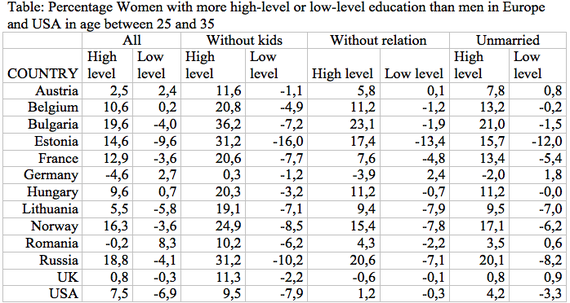Introduction
Over the past several decades, marriage rates have fallen dramatically in the U.S. Many believe that a shortage of 'marriageable' men is the primary culprit. That turns out to be at the very most only half of the picture, as the new CCF policy brief of the Brooking Institute "Is There a Shortage of Marriageable Men?" shows. This policy brief states that if there a shortage of marriageable men, it is only among African Americans and well-educated whites. I follow up the later point and relate the shortage to the increase of female achievement in education relative to those of men (Diprete & Buchmann, 2013). This relative increase of female achievement in education has occurred in many countries and that has consequences for the availability of men for women. Therefore it is interesting to compare the USA with European countries.
USA versus Europe
To compare the marriageable men in USA with Europe I use the harmonized data of the first wave of the Gender and Generations Programme (GGP), a longitudinal survey of 18- to 79-year-olds in 19 European countries. The harmonized data are purposely recoded and cleaned in order to ensure the highest level of cross-national comparability of union formation, childbearing, and educational level. Data from the American National Survey of Family Growth and the British Household Panel Study were included by GGP in the harmonized data, allowing me to test whether the USA is an outlier in family formation and union instability. I restrict myself to men and women in the age between 25 and 35. Low education means achievement educations up till the lowest stage of secondary education; high education means tertiary education.
All women and men
The first two columns show the difference in percentage women and men at a high or low educational level. A positive number means the percentage more women than men having that educational level, a negative number the percentage more men than women having that educational level. With a few exceptions (notably Germany) there is a higher percentage highly educated women compared to highly educated men in the ages between 25 and 35. This means high educated women find less available men with the same educational level. This discrepancy is not the strongest in the USA, but in Bulgaria, Russia, Norway, Estonia, France and Belgium (more than 10%).
Available without children
Women or men with children (irrespective their current relation) are less available for new relations. Columns three and four show the same discrepancies in educational level between men and women, but only for those without children. The discrepancy between percentage highly educated women compared to highly educated men in the ages between 25 and 35 become even larger, due to that child bearing is related to educational level. But the order remains more or less the same Bulgaria, Russia, Estonia (more than 30%), Norway, France, Belgium and Hungary (more than 20%). The USA discrepancy is just below the 10%.
Singles only
Men and women with a current relation (marriage or cohabitation) are less availability for a new relation. Columns five and six show the same discrepancies in educational level between men and women, but only for those without any relation. Due to difference in union-formation between countries by men and women with different educational level, we get another picture. The discrepancy between percentage highly educated women compared to highly educated men in the ages between 25 and 35 is highest in Bulgaria, Russia (more than 20%), Estonia, Norway, Hungary and Belgium (more than 10%). The USA discrepancy is very low.
Unmarried
Married men and women are less availability for a new relation. The last two columns show the same discrepancies in educational level between men and women, but only for those who are not married. Despite the difference in marriage between countries by men and women with different educational level, we get more or less the same picture. The discrepancy between percentage highly educated women compared to highly educated men in the ages between 25 and 35 is highest in Bulgaria, Russia (more than 20%), Estonia, Norway, Hungary and Belgium (more than 10%). The USA discrepancy is low but substantial.
It is education, stupid
Due to the increase of female achievement in education relative to those of men, there is a growing discrepancy between percentage highly educated women compared to highly educated men and between percentage lowly educated men compared to lowly educated women in the ages between 25 and 35. This means less marriageable men for highly educated women and less marriageable women for lowly educated men. This phenomenon is strongest in former communist societies like Russia, Bulgaria, Estonia and Hungary. But it occurs also in Norway, Belgium and France. The high discrepancies in the later countries suggest that employment and income of men is not the main cause of lack of available men for women, but the growing gap between educational attainment by men and women.
Reference
Thomas A. DiPrete and Claudia Buchmann, 2013. The Rise of Women: The Growing Gender Gap in Education and What It Means for American Schools. Russel Sage Foundation
